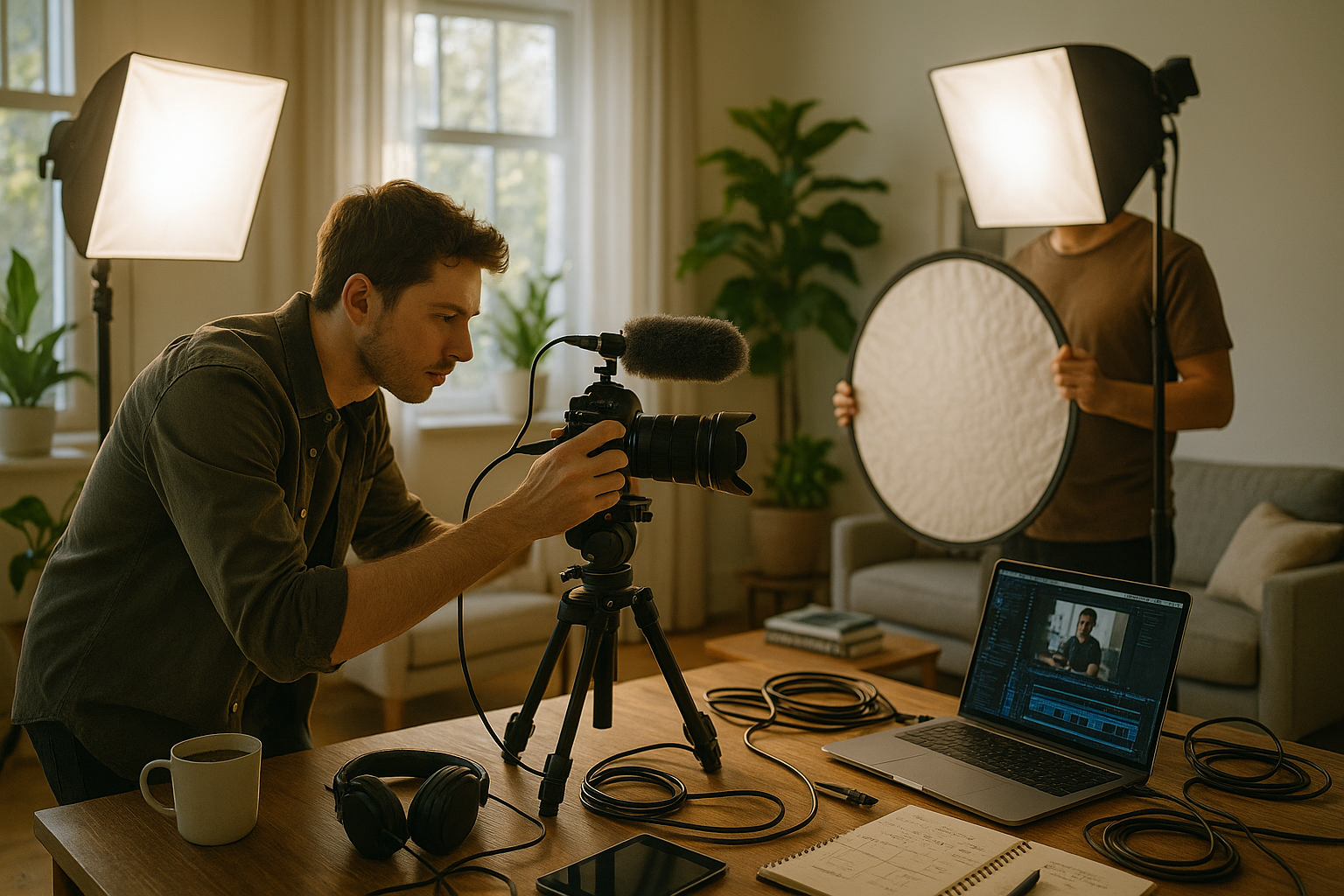The first rays of the morning sun are breaking through the horizon, casting a warm, golden light on everything in sight. 🌅 It’s time to seize the day – and your camera – to capture the magic of every moment. As a videographer, you are not just a passive observer, but an active participant in shaping and immortalizing these moments. But without proper preparation, these golden opportunities can easily slip through your fingers. That’s where a well-structured and meticulously thought-out morning videography checklist comes into play.
This article is designed to be your ultimate guide to building an effective videography checklist. It’s not just about the gear you bring along, but also the mindset, techniques, and strategies you employ to guarantee every capture is as perfect as possible.
Why a Checklist?
First off, why the emphasis on a checklist? 📋 Simple – because the art of videography is inherently complex and multifaceted. A checklist helps ensure that nothing falls through the cracks, from ensuring that your equipment is in optimal condition, to reminding yourself of the specific shots you need to capture. It streamlines your process, helping you stay organized and focused even in the early morning hustle.
Gearing Up
When it comes to equipment, there’s a lot more to consider than just a camera. Your checklist should include a comprehensive rundown of your gear, from lenses and memory cards, to tripods and lighting. 🎥 We’ll delve deeper into what each item can bring to your morning videography endeavors, as well as offering tips on how to get the most out of them.
Capturing the Moment
Once your gear is in check, it’s time to focus on the moments you want to capture. However, capturing a perfect shot is not just about pressing the record button at the right time. 🕰️ It’s about understanding light, composition, and timing, and how these elements interact to create a compelling visual narrative. We’ll take a closer look at these concepts and how to use them effectively in your morning shoots.
Post-Production
Last, but certainly not least, we’ll talk about post-production. Here, we’ll give you a rundown of what to do after the cameras stop rolling. This includes tips on how to organize and backup your footage, how to go about the editing process, and how to utilize color grading and other post-production techniques to bring your morning footage to life. 🖥️
Throughout this article, we aim to provide you with practical, actionable insights. We’ll not only explain what to do, but why it’s important and how it can enhance your videography practice. Whether you’re a seasoned pro or just starting out, this guide is designed to help you capture the beauty of the morning in all its glory. So, grab your coffee, sit back, and let’s dive in. Because in the world of videography, the early bird doesn’t just catch the worm – it captures the perfect shot.
📸 Embrace the Dawn: Why Early Morning is the Golden Hour for Videography
The early morning, often referred to as the “Golden Hour” by photographers and videographers, is an ideal time for capturing stunning visuals. The soft, warm light creates a magical effect that can’t be replicated in post-production. “The Golden Hour: The First and Last Hour of Light in a Day”, a video by The Slanted Lens, offers a comprehensive understanding of this phenomenon (link not provided).
However, to truly exploit this time, one must be prepared. A morning videography checklist becomes essential to ensure that you’re ready to capture the fleeting moments of dawn. This comprehensive guide will provide you with the ultimate morning videography checklist and some expert tips for capturing every moment perfectly.
So, before you hit the snooze button, remember that the early bird gets the worm, or in this case, the best footage! Now, let’s dive into the essential gear you need for your morning videography checklist.
🎥 Essential Gear for Morning Videography
Preparing your gear the night before is a crucial step in ensuring you’re ready to shoot as soon as the sun peeks over the horizon. After all, missing an essential piece of equipment can be disastrous. Here’s what you need to have in your videography toolkit:
- Camera: Of course, this is the primary piece of equipment. Whether you’re using a DSLR, a mirrorless camera, or a smartphone, ensure it’s in good working condition.
- Lenses: Wide-angle lenses are excellent for capturing expansive landscapes during sunrise. Also, consider packing a macro lens if you plan on shooting close-ups of nature or dewdrops on leaves.
- Filters: Neutral Density (ND) filters can help manage the exposure, especially during the bright parts of the golden hour.
- Battery and Memory Cards: Always have extra batteries and memory cards. There’s nothing worse than running out of battery or storage in the middle of a shoot.
For a more in-depth look into the essential gear for videography, consider watching “Videography Gear Essentials” by Peter McKinnon on YouTube (link not provided).
🌄 Understanding and Utilizing Natural Light
One of the main advantages of morning videography is the natural light. But using natural light effectively requires a solid understanding of its characteristics and how they change throughout the morning.
In the early morning, the sun is low in the sky, providing soft, diffused light and long shadows. This light can add depth and dimension to your footage, making it visually appealing. As the morning progresses, the light becomes harsher and can cause overexposed footage. Therefore, understanding how to adjust your camera settings to adapt to changing light conditions is crucial.
For an insightful guide on using natural light in videography, check out “Natural Light in Cinematography – Good or Bad?” by Film Riot on YouTube (link not provided).
🔎 Focusing on Composition
Composition is a critical aspect of videography that can turn an ordinary shot into an extraordinary one. Even with the most advanced equipment, poor composition can result in uninspiring footage. Therefore, it’s important to understand and apply key composition techniques, such as the rule of thirds, leading lines, and framing.
Let’s look at a comparative table of these three composition techniques:
| Technique | Description | Benefit |
|---|---|---|
| Rule of Thirds | Imagine your frame divided into nine equal parts by two equally spaced horizontal lines and two equally spaced vertical lines. Place your subject along these lines or at their intersections. | Creates balance and directs the viewer’s attention. |
| Leading Lines | Use the natural lines in your scene (such as roads, rivers, or shadows) to lead the viewer’s eyes to your subject. | Creates depth in your shot and guides the viewer’s focus. |
| Framing | Use natural frames (like windows, arches, or trees) to isolate your subject. | Highlights your subject and adds a sense of depth and layer to your footage. |
For more on composition techniques in videography, you can watch “Composition Techniques for Better Films” by Aputure on YouTube (link not provided).
Remember, morning videography is not just about waking up early. It requires careful planning, understanding of light, and attention to composition. But with this ultimate morning videography checklist, you’re equipped to capture every moment perfectly. So, rise and shine, and start creating stunning visuals!

Conclusion
In conclusion, we have traversed the technical realm, delving deep into complex aspects of IT and engineering, while endeavoring to make the journey comprehensible. The entire expedition was not just about understanding and decoding technical concepts but also about identifying their role and importance in our everyday lives. Technology is the fulcrum of modern-day existence and understanding its workings is crucial for innovation and advancement.
Throughout this article, we have dissected various intricate aspects of IT and engineering. From the fundamentals of software development to the nuances of hardware engineering, we have tried to encompass as much as possible, ensuring we deliver a wholesome understanding.
The section on software development highlighted how coding is essentially a form of communication, a dialogue between the human brain and the machine. We explored different programming languages, their unique characteristics, and how they serve as the backbone of software engineering. 💻
When we ventured into hardware engineering, we took a microscopic look into the world of microprocessors, understanding their functionalities and marveling at their minuscule yet mighty role in powering our electronic devices.🔬
In this ever-evolving world, technology is constantly upgrading. The article’s segment on emerging trends in IT and engineering pointed out the key role these sectors play in spearheading this change. Be it artificial intelligence, machine learning, or IoT, these cutting-edge technologies are shaping our future and driving the world towards a more digital, connected, and automated era.🚀
There is no denying the importance and relevance of the topics discussed in this article. Each one of us, whether directly or indirectly, is impacted by the developments in these fields. Therefore, it becomes all the more important to stay informed and updated.
If you found this article insightful and informative, do not hesitate to share it with others who might benefit from it. Remember, knowledge grows when shared. So, go ahead and disseminate the wealth of information.📚
Feel free to leave a comment with your thoughts, questions, or suggestions. Engaging in a discussion is a great way to learn, and I am always eager to hear from you.👂
If you are interested in diving deeper into the subjects discussed, I encourage you to check out these resources:
– [The Pragmatic Programmer](https://www.pragprog.com/titles/tpp20/the-pragmatic-programmer-20th-anniversary-edition/)
– [Introduction to the Theory of Computation](https://www.amazon.com/Introduction-Theory-Computation-Michael-Sipser/dp/113318779X)
Knowledge is a continuous journey, and there’s always more to learn and discover. So, let’s keep exploring and keep learning. After all, the world of IT and engineering is vast and constantly evolving. What might seem like an insurmountable challenge today could be a piece of cake tomorrow. As long as we keep learning, we keep growing. 🌱
Happy learning! 🎓



